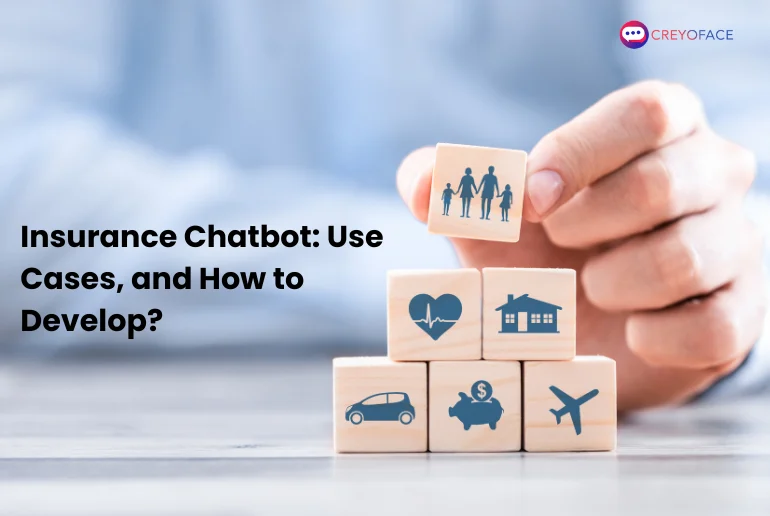Introduction
Ella was going through the mail and found a letter from her insurance company—a reminder that her policy was due for renewal.
She opens her laptop and goes to her insurance provider’s website, expecting to find a contact form.
Instead, a chat window pops up in the corner of the screen.
“Hi there! I’m InsuraBot, your 24/7 assistant. I see your policy is up for renewal. Can I help you with that now?”
She renews her policy and adds all through Bot’s prompt assistance.
With no phone calls required, she closes her laptop with satisfaction.
Does your business have a chatbot like this?
If not, don’t worry. We will guide you through how to develop one.
This article explores how an insurance chatbot can help companies, how to use them right, and why it’s important.
Challenges Across the Insurance Value Chain
The insurance industry is a complex world where every detail matters. Insurance value chain is at the heart of it all. It’s the path from figuring out risks to fixing claims. Let’s explore the Insurance value chain and the possible challenges that can happen in this value chain.
Insurance Value Chain
The insurance value chain is the sequence of activities an insurance company performs to create customer value. The primary elements of the insurance value chain include the following.
- Insurance Policy: It refers to the creation, management, and administration of insurance contracts.
- Claims Processing: This involves managing and settling claims made by policyholders.
- Risk assessment in insurance is figuring out how likely it is that something bad might happen and how much it could cost.
- Customer Support: Ensuring customers are satisfied and supported throughout their journey.
- Sales and Marketing: These activities focus on acquiring new customers and retaining existing ones.
Prominent Challenges in Insurance Value Chain
Getting insurance might seem straightforward, but it’s really a journey with several steps, each with its own set of challenges.
From choosing a policy to handling a claim, it’s not always smooth sailing. Let’s go through these steps together and see what challenges come across.
Policy Insurance
Dealing with insurance policies isn’t always easy. Insurers often come across problems that can slow things down and make customers less happy. Here’s a look at the main issues they are facing.
- Complex Agreements: Insurance contracts can be complicated, often leading to confusion among policyholders.
- Administrative Burdens: The tasks involved in managing, renewing, and modifying policies can lead to inefficiencies.
- Regulatory Compliance: Adapting to the constant changes in regulations presents a continuous challenge.
Claims Processing
Handling insurance claims is a big deal for both customers and companies. It’s when companies show they can be trusted by sticking to their promises. However, it’s not always easy. Let’s take a closer look at the challenges in processing claims.
- Fraud Detection: Distinguishing between authentic and fraudulent claims is a constant issue.
- Process Delays: Manual processing can slow down operations, causing customer dissatisfaction.
- Evaluation Errors: Mistakes in claims assessment can lead to financial losses or unsatisfied customers.
Risk Assessment
Risk assessment in the insurance world is like being a weather forecaster for all potential problems. Insurers must predict what could go wrong, from minor accidents to big disasters. But it’s tricky. Here are some challenges involved in risk assessment.
- Data Quality: Data quality is crucial for correctly assessing risk; if the data is incomplete or old, it can lead to incorrect conclusions.
- Evolving Risks: New risks, such as cyber threats, are continuously emerging, making it hard to stay updated.
- Model Limitations: Even the best risk models aren’t perfect and can miss rare but significant events.
Customer Support
Supporting customers in insurance is a huge part of keeping them happy. Let’s see some common challenges in insurance customer support.
- High Query Volumes: High volumes of customer queries, particularly during peak times, can be challenging.
- Uniform Service Quality: Maintaining consistent service quality across various channels is demanding.
- Complex Issue Resolution: Resolving tricky problems requires deep expertise.
Sales and Marketing
Selling insurance isn’t easy. Insurers have to figure out how to get new customers and keep the ones they have in the market. Here are some challenges faced by the sales and marketing team of an insurance company.
- Evolving Customer Demands: The digital era demands smooth online experiences, pressuring traditional sales approaches.
- Trust Building: The insurance sector often faces trust issues, necessitating ongoing efforts to build and maintain credibility.
- Competitive Landscape: Standing out in the competitive market is a significant challenge.
AI chatbot use cases for Insurance
AI chatbots are transforming the insurance sector by providing efficient and customer-friendly solutions. We learned the different operations of insurance companies from the insurance value chain. Now, let’s see how AI chatbots for insurance can carry out these operations.
Policy Insurance
In the world of insurance, chatbots are like your personal guide. They take those tricky insurance words and make them simple, so you know exactly what you’re getting. Plus, they’re good at compiling a policy that fits just what you need just by chatting with you.
And if you ever need to change your policy, like increase your coverage or something, they’re on it fast. It’s like having a helpful insurance assistant, always ready to make life easier.
Let’s picture a scenario. Maria just bought a new car and needs to insure it. She is new to car insurance and wants to understand her coverage options. She starts a conversation with an insurance company’s chatbot.

Claim Process
Chatbots are like your 24/7 digital insurance buddy. They make starting a claim as easy as chatting with a friend. Need to know what’s happening with your claim?
Ask your chatbot and get updates instantly; no waiting on hold. They’re always ready to answer your questions, day or night, helping you understand the claim process. Quick, clear, and make life easier – the chatbot’s promise in insurance claims today.

Risk Assessment
Chatbots are making risk assessment in insurance much more accessible. They quickly gather essential details from users, such as daily health habits for life insurance or the safety features in a car.
It helps create a first look at the user’s risk level and what insurance might cost them. Plus, chatbots are always ready to answer questions about risk factors, how they affect insurance prices or any discounts that might apply, helping users understand their options better.

Customer Support
Insurance chatbots provide an invaluable service with their uninterrupted availability, ensuring that customers have constant access to assistance and support. These intelligent systems manage many policy inquiries, adeptly handling questions about policy terms, expiration dates, coverage details, and upcoming premium obligations.
Furthermore, these automated agents are helpful in the qualitative growth of insurance services because they proactively engage with customers to gather feedback after interactions or claims processing. Your thoughts help the insurance company learn and improve so things keep getting better for everyone.
Let’s picture a scenario where a customer named Alex has a question about their insurance policy after office hours. Here’s how an insurtech chatbot assists Alex.

Sales and Marketing
When a visitor lands on the website, the chatbot collects the essential information. Moreover, When a customer decides to buy an insurance policy, these chatbots make it easy, showing how to get started without any fuss.
Also, they keep potential and current customers hooked with interactive content, quizzes, and timely follow-ups, nudging them gently toward making a purchase. They gather valuable insights, helping the company fine-tune its marketing strategies and product offerings to suit customer needs better, leading to a more efficient sales cycle.

How AI Chatbots Helping Insurtech
We’ve seen how AI chatbots can do many helpful things, from answering customer questions to sorting out claims. But their influence doesn’t end there. Heading into the insurtech, it becomes apparent that AI chatbots aren’t merely addressing challenges—they’re reinventing the insurance industry.
Now, let’s delve into how Insurance chatbot development specifically boosts the insurtech ecosystem, taking modern insurance to new heights.
Automated Underwriting
The landscape of the insurance world is undergoing a significant makeover, moving away from its traditional, broad strategy for assessing risk to a more customized, individual-centric model.
By deploying Insurtech chatbots for underwriting, insurance companies can manage operational expenses more effectively. These automated systems eliminate the need for a large team of specialized underwriters, saving on high salaries and related employee costs.
Machine Vision
Machine vision chatbots in insurance are an exciting technological leap, taking the capabilities of standard chatbots further by enabling them to ‘see’ and ‘understand’ images.
These chatbots can analyze photos of car accidents, home damage, or other insurance claim evidence. By comparing images against vast databases, they quickly assess the extent of the damage and facilitate speedy claim resolutions.
Triaging Claims
In the insurance industry, chatbots can triage claims by quickly sorting through new cases as they come in. These intelligent chatbots check each claim to see which ones are the most urgent or severe. They categorize claims by severity and direct them to the suitable department. For example, they can tell a car accident claim is immediate if it involves injuries.
The chatbots can then decide which claims the insurance staff should look at first, ensuring customers with the most critical needs get help quickly. It not only speeds up the process for everyone but also helps the insurance company handle claims more efficiently.
Predictive Data Analysis
The data generated from Insurtech chatbot interactions is precious. By examining this data, companies can identify new trends, pinpoint customer preferences, and recognize common issues that customers face. Utilizing the data gathered, chatbots can help in predictive analysis. They can estimate the likelihood of future claims or spot chances for suggesting additional products or services to customers.
How to develop an Insurance Chatbot Using Creyoface
If you own an insurance company, developing an Insurtech chatbot is a must for assisting your customers.
Creyoface helps you to develop an insurance chatbot with an easy-to-follow, five-step, no-code approach.
- Register with Creyoface and choose a chatbot template.
- Create your chatbot’s workflow with our drag-and-drop widgets.
- Train the chatbot’s conversational skills with our contextual understanding and FAQ training tools.
- Customize the look and feel of your chatbot to reflect your brand’s identity.
- Deploy your chatbot across various channels.
Conclusion
Today, simplifying processes for customers is a priority in the insurance industry, and for this, we have insurance bots. Here’s a recap of what we’ve covered in this blog.
- Insurance chatbots serve as a pivotal tool for engaging customers with real-time, personalized interactions.
- An overview of the insurance value chain and some challenges associated with it.
- Insurance bots are experts at overcoming challenges such as claims processing delays, underwriting efficiency, and personalized customer outreach.
- A detailed explanation of how AI chatbots help Insurtech companies.
- Introducing the no-code approach of chatbot development through creyoface that simplifies the development of insurance chatbots.
Please read our blog on How to create an AI chatbot for free without coding to develop your Insurtech chatbot.
Ready to Start. Sign in to Creyoface to develop your Insurance chatbots.
Ready To Explore?
Frequently Asked Questions?
An insurance chatbot is a specialized form of artificial intelligence designed to interact with users through text or voice interfaces. Moreover, it assists with various tasks, such as answering policy questions, guiding customers through the claims process, providing quotes, and offering real-time support, all without human intervention.
How do insurance chatbots work?
Insurance chatbots use natural language processing (NLP) to understand user queries and machine learning to improve responses over time. They access a database of insurance knowledge to provide accurate information and can integrate with various backend systems to perform tasks like initiating claims or providing billing information.
Can insurance chatbots handle complex customer queries?
Yes, advanced insurance chatbots are equipped to handle a range of complex queries. They are programmed to escalate issues they cannot resolve to human agents, ensuring that customers always have access to the help they need.








